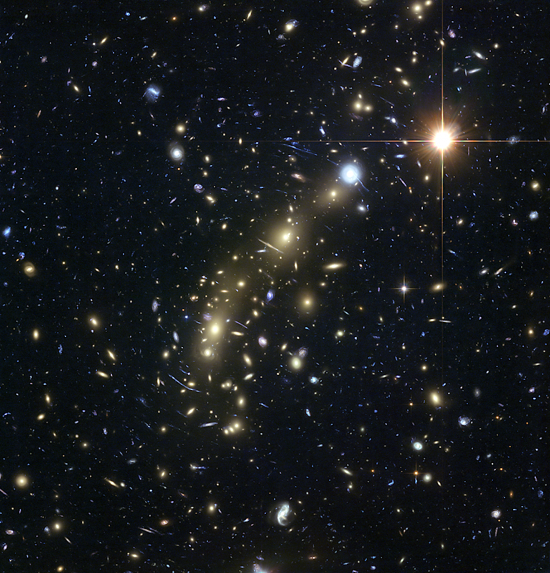
March 30, 2020
In an Electric Universe, galaxies evolve because large-scale plasma discharges form Birkeland currents.
To those familiar with ideas like electricity in space, the cosmos appears to be interlaced with electric circuits made up of energized filaments at every scale. At the largest scale, there are electromagnetic loads in the circuits converting electrical energy into rotational energy. They are known as galaxies. Why stars in galaxies tend to coalesce in long arcs like bright beads on a line is one of a hundred mysteries that conventional cosmology must confront. No gravity-only hypothesis can resolve the issue of star formation, in general, but what is seen within the barred spirals and elliptical whirlpools that congregate in million-light-year clusters continues to elude explanation.
Filaments expand and explode, throwing off plasma that can accelerate to near light-speed. Jets from opposite poles of a galaxy end in energetic clouds emitting X-ray frequencies. These phenomena owe their explanations to plasma science and not gas kinetics, gravity, or particle physics. Astrophysicists see electromagnetic fields but since they do not see the underlying electricity, they are at a loss.
Astronomers maintain that galaxies are clouds of hydrogen gas and intergalactic dust that are assembled by gravity until they coalesce into glowing thermonuclear fires. They also believe that most galaxies contain black holes of unbelievable magnitude. It is those protean gravity gods that supposedly cause galaxies to spin, jets of gamma and X-rays to appear, and “radio lobes” sometimes larger than the parent galaxy to form.
Electricity requires charged particles to move. Something not considered when researchers attempt to explain structure in the Universe is that for charged particles to move, they must move in a circuit. Energetic events cannot be explained by local conditions, alone. The effects of an entire circuit must be considered. For that reason, while the consensus scientific worldview only permits isolated “islands” in space, the Electric Universe emphasizes connectivity with an electrically active network of “transmission lines” composed of the aforementioned Birkeland current filaments.
In plasma, electrons are stripped from atomic nuclei, since electron orbital dynamics can be overcome by thermionic and other energy sources. When regions in plasma develop excess charge electric discharges can take place, forming magnetic sheaths along the axes of discharge. If there is enough charge flow, the sheaths will glow; sometimes forming other sheaths. Those regions of isolated charge, or “cells”, are known as double layers.
Double layers induce intense electric fields, which accelerate charged particles. When electric charge spirals in an electromagnetic field, X-rays, extreme ultraviolet, and sometimes gamma rays are detected. Those electromagnetic forces create filaments that tend to attract each other in pairs. Electric fields that form along plasma strands can generate an attractive force orders of magnitude greater than gravity. Although, due to their isolated sheathes, instead of merging, Birkeland currents twist into helices that rotate faster as they become more tightly compressed.
To repeat: plasma physics fits observations and behaviors better than kinetics or gravity. As previously written, plasma is not a substance, it is an emergent phenomenon, so it can not be analyzed in terms of its component parts, it arises in response to complicated interactions.
The filaments of electric charge that move in closed circuits through plasmas can attract matter to them over vast distances. Double layers might glow in visible or infrared light. However, plasma might also initiate dark discharges. Perhaps those are the filamentary “dark lanes” seen by astronomers. The Milky Way galaxy shares characteristics with the rest of its galactic family. Its halo of stars, its filamentary structures, lobes of radiation, its microwave haze, and other observed phenomena point to the Milky Way’s electrical nature.
Stephen Smith
The Thunderbolts Picture of the Day is generously supported by the Mainwaring Archive Foundation.












